








The entire Daguerreotype process is comprised in seven distinct operations; viz:
1.--Cleaning and polishing the plate.
2.--Applying the sensitive coating.
3--Submitting the plate to the action of light in the camera.
4.--Bringing out the picture; in other words rendering it visible.
5.--Fixing the image, or making it permanent--so that the light may no longer act upon it.
6.--Gilding: or covering the picture with a thin film of gold--which not only protects it, but greatly improves its distinctness and tone of color.
7.--Coloring the picture.
For these various operations the following articles--which make up the entire apparatus of a Daguerrean artist--must be procured
1.--THE CAMERA.--(Fig. 5.). The Camera Obscura of the Italian philosophers, although highly appreciated, on account of the magical character of the pictures it produced, remained little other than a scientific toy, until the discovery of M. Daguerre. The value of this instrument is now great, and the interest of the process which it so essentially aids, universally admitted. A full description of it will therefore be interesting.
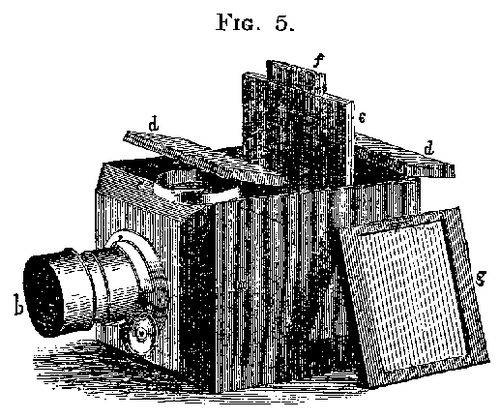
The camera is a dark box (a), having a tube with lenses (b) placed in one end of it, through which the radiations from external objects pass, and form a diminished picture upon the ground glass (g) placed at the proper distance in the box to receive it; the cap c covering the lenses at b until the plate is ready to receive the image of the object to be copied.
Thus a (fig. 6.) representing the lens, and b the object desired to be represented, the rays (c, c) proceeding from it fall upon the lens, and are transmitted to a point, which varies with the curvature of the glass, where an inverted image (d) of b is very accurately formed. At this point, termed the focus, the sensitive photographic material is placed for the purpose of obtaining the required picture.
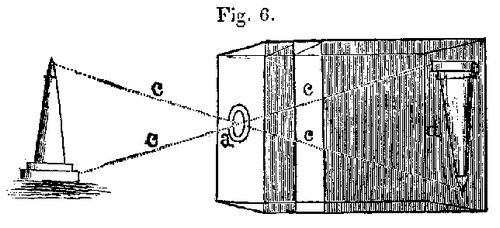
The great desideratum in a photographic camera is perfect lenses. They should be achromatic, and the utmost transparency should be obtained; and under the closest inspection of the glass not the slightest wavy appearance, or dark spot should be detected; and a curvature which as much as possible prevents spherical aberration should be secured. The effect produced by this last defect is a convergence of perpendiculars, as for instance; two towers of any building, would be represented as leaning towards each other; and in a portrait the features would seem contracted, distorted and mingled together, so as to throw the picture out of drawing and make it look more like a caricature than a likeness. If the lens be not achromatic, a chromatic aberration takes place, which produces an indistinct, hazy appearance around the edges of the picture, arising from the blending of the rays.
The diameter and focal length of a lens must depend in a great measure on the distance of the object, and also on the superficies of the plate or paper to be covered. For portraits one of 1 1/2 inches diameter, and from 4 1/2 to 5 1/2 inches focus may be used; but for distant views, one from 2 inches to 3 inches diameter, and from 8 to 12 inches focal length will answer much better. For single lenses, the aperture in front should be placed at a distance from it, corresponding to the diameter, and of a size not more than one third of the same. A variety of movable diaphragms or caps, to cover the aperture in front, are very useful, as the intensity of the light may be modified by them and more or less distinctness and clearness of delineation obtained. These caps alway come with Voitlander instruments and should be secured by the purchaser.
Though the single acromatic lens answers very well for copying engravings; taking views from nature or art, for portraits the double should always be used. The extensive manufacture of the most approved cameras, both in Europe and in this country, obviates all necessity for any one attempting to construct one for their own use. Lenses are now made so perfect by some artisans that, what is called the "quick working camera" will take a picture in one second, while the ordinary cameras require from eight to sixty.
The camera in most general use is that manufactured by Voitlander and Son of Germany. Their small size consists of two seperate acromatic lenses; the first, or external one, has a free aperture of 1 1/2 inches; the second, or internal, 1 5/8 inches; and both have the same focus, viz: 5 3/4 inches. The larger size differs from the smaller. The inner lens is an achromatic 3 1/4 inches diameter, its focal length being 30 inches. The outer lens is a meniscus--that is bounded by a concave and convex spherical surface which meet--having a focal length of 18 inches. For every distant view, the aperture in front is contracted by a diaphram to 1/8 of an inch. By this means the light is reflected with considerable intensity and the clearness and correctness of the pictures are truly surprising.
THE AMERICA instruments are constructed on the same principle and many of them are equally perfect. Mr. Edward Anthony of 205 Broadway, New York city, has constructed, and sold cameras fully equal to the German and for which Voitlander instruments have been refused in exchange by the purchaser.
The ordinary camera box (see fig. 5, a) varies in size to suit the tube, and is termed medium, half, or whole. Within the box is a slide to assist in regulating the focus, and in enlarging or diminishing the picture. In one end of this slide is a springed groove into which the ground-glass spectrum (g fig. 5) is slid, for the purpose of more conveniently arranging the focus. After the plate is prepared it is placed in the holder--partly seen at e, fig. 5, and covered with the dark slide f, fig. 5; the spectrum is then withdrawn and the holder takes its place, and the lids d, d, are closed after removing the dark slide f. The plate is now ready to receive the image, and the cap c may be removed to admit the light into the box.
A camera constructed by Voitlander is thus described by Mr. Fisher. "It is made entirely of brass, so that variations of climate has no effect upon it. It is very portable and when packed in its box, with all the necessary apparatus and materials for practising the Daguerreotype art, occupies but very little space. It is not, however, well adapted for the Calotype process."
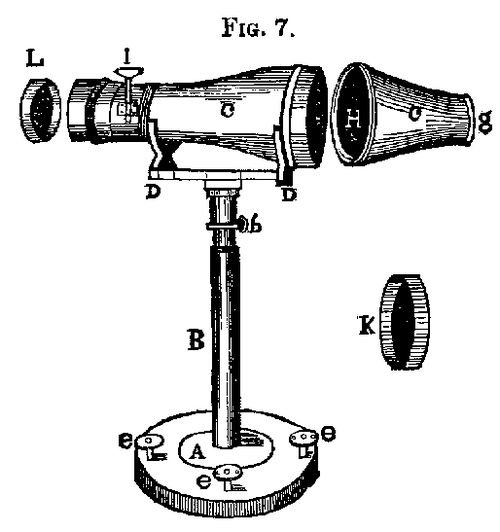
"The brass foot A (fig. 7.), is placed on a table, or other firm support, and the pillar B. screwed into it; the body of the camera, C, C is laid into the double forked bearing D. D. The instrument is now properly adjusted by means of the set screws, e, e, e, in the brass foot, or it may be raised, lowered, or moved, by the telescope stand, and when correct, fixed by the screw b. The landscape to be delineated is viewed either through the small lens, g, or with the naked eye on the ground glass plate H, the focus being adjusted by the screw I. The optical part of the instrument consist of the small set of achromatic lenses already described. When the portrait or view is deliniated on the ground glass to the entire satisfaction of the operator, the brass cap L is placed over the lens, and the entire body is removed away into the dark, taking care not to disturb the position of the stand. The body is now detached at the part H, and the prepared paper or plate enclosed in the brass frame work introduced in its place; the whole is again placed upon the pedestal, the brass cap L is removed, by which the paper or plate is exposed to the full influence of the light, after which the cap is again replaced.
Mr. Woodbridge, of this city, has constructed an instrument for taking full length portraits on plates 10 by 13 inches, which is worthy of some notice. It is a double camera, consisting of two boxes, placed in a frame, one above the other, and so arranged as to slide easily up and down. After the focus has been adjusted, on the object, in both cameras, the plate is put into the upper box, in the manner already described, until the superior portion of the figure is complete; it is then placed in the second box and the lower extremities obtained. The adjustment of the instrument is so complete that a perfect union of the parts is effected in the picture without the least possible line of demarkation being visible. Fig. 8 gives a front view of this instrument.
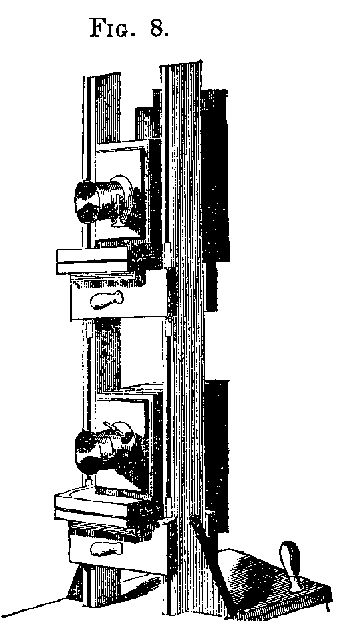
Fig. 9 represents Talbot's Calotype Camera,--a very beautiful instrument.
The copying camera box has an extra slide in the back end, by which it may be considerably lengthened at pleasure.
II.--CAMERA STAND.--The best constructed stands are made of maple or black walnut wood, having a cast iron socket (a, Fig. 12,) through which the sliding rod b passes, and into which the legs c, c, with iron screw ferules are inserted. The platform d is made of two pieces, hinged together, as at e, and having a thumb screw for the purpose of elevating or depressing the instrument.
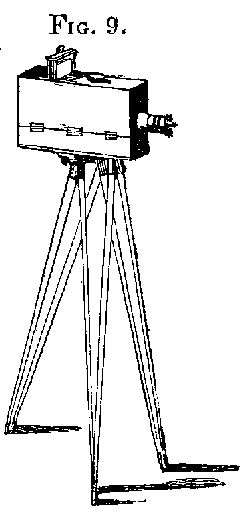
III. MERCURY BATH.--Fig. 13 gives a front view of the mercury bath now in general use in this country for mercurializing and bringing out the picture. It is quite an improvement on those first used. To make it more portable it is in three pieces, a b and c; having a groove e on one side to receive the thermometre tube and scale by which the proper degree of heating the mercury is ascertained. Into the top are nicely fitted two or three iron frames, with shoulders, for the plate to rest in, suitable for the different sizes of plates. The bath is heated by means of a spirit lamp placed under it. From two to four ounces of highly purified mercury are put into the bath at a time.
IV. PLATE BLOCKS AND VICES.--There are several kinds of this article in use; I shall describe the two best only.
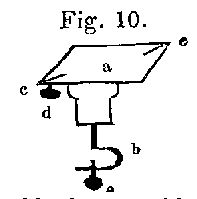
Fig. 10 gives an idea of the improvement on the English hand block. The top a is perfectly flat and smooth--a little smaller than the plate, so as to permit the latter to project a very little all around--having at opposite angles c c two clasps, one fixed the other moveable, but capable of being fastened by the thumb screw d, so as to secure the plate tightly upon the block. This block turns upon a swivle, b, which is attached to the table by the screw c, This block is only used for holding the plate while undergoing the first operation in cleaning.

Fig. 11, shows the form of Lewis' newly patented plate vice, which for durability, simplicity and utility is preferable to all others. It consists of a simple platform and arm of cast iron, the former, a, having a groove, d, in the centre for fixing the different sizes of plate beds, e--and the latter supporting the leaves, e f. On this vice which is secured to a table, or bench, the plate receives its finishing polish with rouge, or prepared lampblack. Mr. Lewis gives the following directions for its use. "As the cam wears tighten it with the adjusting screw (g) so as to allow the lever (f) to fall back into a horizontal position; the plate being in its place at the time. Oil the wearing parts occasionally."
Some Daguerreotypists, however, use a foot lathe with buff wheels of various forms; but this vice is sufficient for all ordinary purposes.
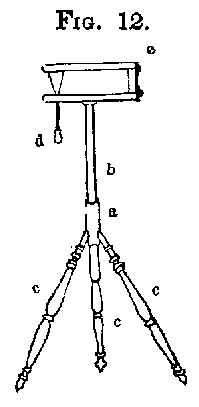
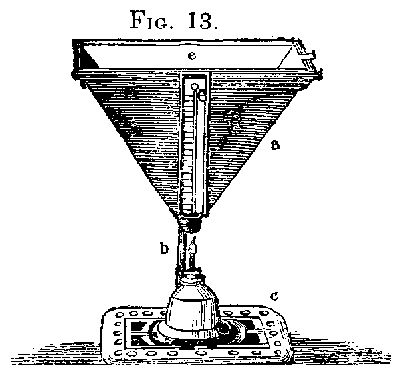
V. COATING BOXES.--The usual form for iodine and bromine boxes is see, at figs. 14 and 15. They are far superior to those in use with the English operators. Each consists of a wooden box (a,) having firmly embeded within it a stout glass jar (c), the edges of which are ground. Over this is placed the sliding cover b, double the length of the box, one half occupied by a piece of ground glass (e), tightly pressed upon the glass pot by a spring (i) beneath the cross bar g, and fits the pot so accurately that it effectually prevents the escape of the vapor of the iodine, bromine or other accelerating liquid contained therein. The other half of the lid is cut through, shoulders being left at the four angles for the different sizes of frames, designed to recieve the plate while undergoing the coating process. When the plate is put into the frame, the cover b is shoved under the second lid h and when coated to the proper degree, it resumes its former position and the plate is placed in the holder of the camera box. To test the tightness of the box, light a piece of paper, put it into the pot and cover it with the sliding lid. The burning paper expels the air from the pot, and if it be perfectly tight you may raise the whole box by the lid.
VI. GLASS FUNNELS.--Are a necessary article to the Daguerreotypist, for filtering water, solutions, &c.

VII. GILDING STAND.--For nervous persons the gilding stand is a useful article. It is adjusted to a perfect level by thumb screws placed in its base.
VIII. SPIRIT LAMPS.--The most useful and economical of those made are the Britania, as they are less liable to break; and the tube for the wick being fastened to the body by a screw renders it less liable to get out of order or explode. Glass is the cheapest, and for an amateur will do very well, but for a professed artist the Britania should always be obtained.
IX. COLOR BOX.--These are generally found on sale at the shops, and usually contain eight colors, four brushes and a gold cup. The artist would, however, do well to obtain, all the colors mentioned in the last chapter of this work, and be sure to get the very best, as there are various qualities of the same color, particularly carmine, which is very expensive, and the cupidity of some may induce them to sell a poor article for the sake of larger profits.
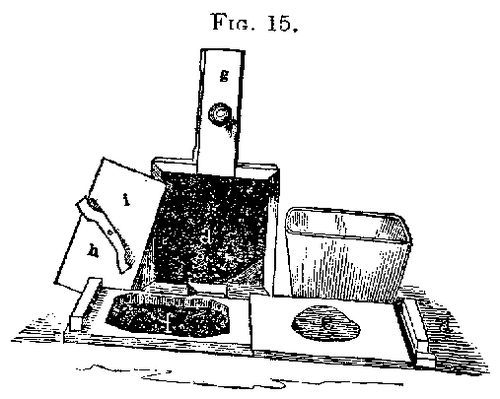
STILL.--Daguerreotypists should always use distilled water for solutions, and washing the plate, as common water holds various substances in solution which detract very materially from the excellence of a photograph, and often gives much trouble, quite unaccountable to many. For the purpose of distilling water the apparatus represented at Fig. 16 is both convenient and economical.
It may be either wholly of good stout tin, or of sheet iron tinned on the inside, and may be used over a common fire, or on a stove. A is the body, which may be made to hold from one to four gallons of water, which is introduced at the opening b, which is then stopped by a cork. The tube d connects the neck a of the still with the worm tub, or refrigerator B, at e, which is kept filled with cold water by means of the funnel c, and drawn off as fast as it becomes warm by the cock f. The distilled water is condensed in the worm--and passes off at the cock b, under which a bottle, or other vessel, should be placed to receive it. The different joints are rendered tight by lute, or in its absence, some stiff paste spread upon a piece of linen and wrapped around them will answer very well; an addition of sealing wax over all will make them doubly secure.
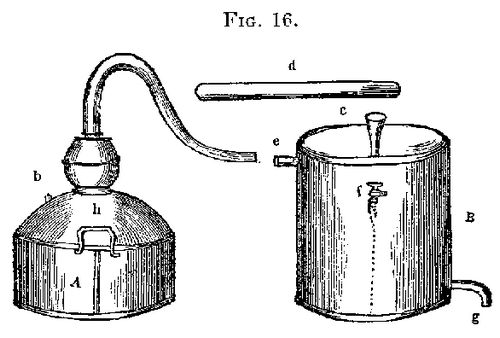
HYGROMETER.--This is an instrument never to be found, I believe, in the rooms of our operators, although it would be of much use to them, for ascertaining the quantity of moisture floating about the room; and as it is necessary to have the atmosphere as dry as possible to prevent an undue absorption of this watery vapor by the iodine &c., and to procure good pictures,--its detection becomes a matter of importance. Mason's hygrometer, manufactured by Mr. Roach and sold by Mr. Anthony, 205 Broadway, New York is the best in use.
It consists of two thermometre tubes placed, side by side, on a metalic scale, which is graduated equally to both tubes. The bulb of one of these tubes communicates, by means of a net-work of cotton, with a glass reservoir of water attached to the back of the scale. Fig. 17 and 18 represent a front and back view of this instrument.
Fig. 17 is the front view, showing the tubes with their respective scales; the bulb b being covered with the network of cotton communicating with the reservoir c fig. 18, at d.
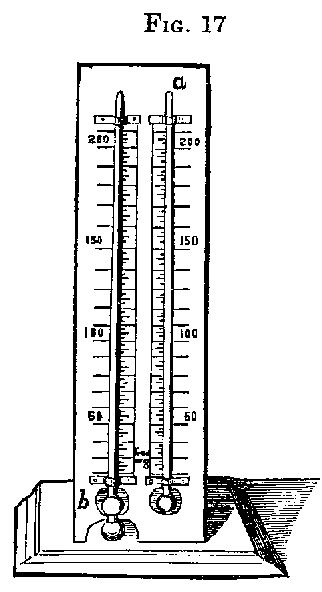
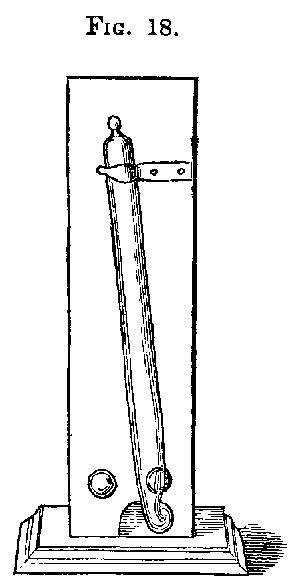
The evaporation of the water from this bulb decreases the temperature of the mercury in the tube b in proportion to the dryness of the atmosphere, and the number of degrees the tube b indicates below that of the other, shows the real state of the atmosphere in the room; for instance, if b stands at forty and a at sixty-one the room is in a state of extreme dryness, the difference of twenty-one degrees between the thermometers--let a stand at any one point--gives this result. If they do not differ, or there is only four or five degrees variation, the atmosphere of the room is very moist and means should be taken to expel the superfluous quantity.
HEAD RESTS.--The button head rest with chair back clip, A fig. 19--is much the best for travelling artists, as it can be taken apart, into several pieces and closely packed; is easily and firmly fixed to the back of a chair by the clamp and screw a and b, and is readily adjusted to the head, as the buttons c, c and arms d, d are movable.
Sometimes the button rest is fixed to a pole, which is screwed to the chair; but this method is not so secure and solid as the clip and occupies more room in packing. Both the pole and clip, are furnished in some cases with brass band rests instead of the button; but the only recommendation these can possibly possess in the eyes of any artist, is their cheapness.

For a Daguerreotypist permanently located the independent iron head-rest, B fig. 19, is the most preferable, principally on account of its solidity. It is entirely of iron, is supported by a tripod (a) of the same metal and can be elevated by means of a rod (b) passing through the body of the tripod, to a height sufficient for a person, standing, to rest against.
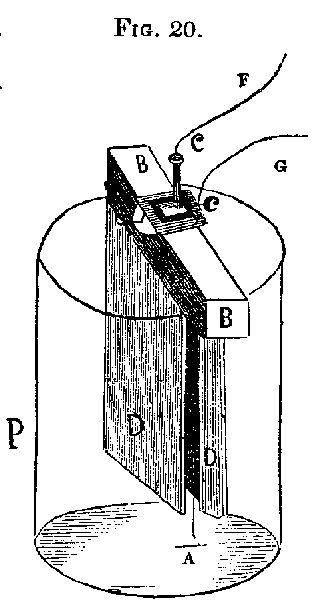
GALVANIC BATTERY.--This article is used for the purpose of giving to imperfectly coated plates a thicker covering of silver. The form of battery now most universally employed for electrotype, and other galvanic purposes, is Smee's--Fig. 20. It consists of a piece of platinized silver, A, on the top of which is fixed a beam of wood, B, to prevent contact with the silver. A binding screw C is soldered on to the silver plate to connect it with any desired object, by means of the copper wire, e. A plate of amalgamated zinc, D, varying with the fancy of the operator from one half to the entire width of the silver is placed on each side of the wood. This is set into a glass vessel, P,--the extreme ends of the wood resting upon its edge--on which the acid with which it is charged has no effect. The jar is charged with sulphuric acid, (common oil of vitriol) diluted in eight parts its bulk of water. The zinc plates of the battery have been amalgamated with quicksilver, and when the battery is set into the jar of acid there should be no action percieved upon them when the poles F, G, are not in contact. Should any action be percieved, it indicates imperfect amalgamation; this can be easily remedied by pouring a little mercury upon them immediately after removing them from the acid, taking care to get none upon the centre plate A.
Directions for use.--A sheet of silver must be attached to the wire connected with the centre plate A of the battery, and placed in the silver solution--prepared as directed below. The plate to be silvered is first cleaned with diluted sulphuric acid, and then attached to the wire, G, proceeding from the zinc plates D, D, and placed in the silver solution, opposite the silver plate attached to the pole F, and about half an inch from it. A slight effervescence will now be percieved from the battery, and the silver will be deposited upon the Daguerreotype plate, while at the same time a portion of the silver plate is dissolved.
To prepare the solution of silver.--Dissolve one ounce of chloride of silver in a solution of two ounces of cyanide of potassium, previously dissolved in one quart of water. The oxide of silver may be used instead of the chloride. This solution is put into a tumbler, or other vessel.
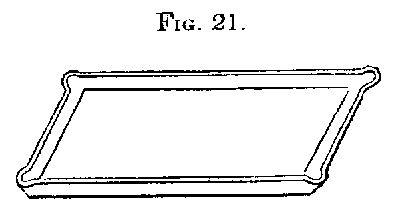

This battery with the necessary articles for using it may be obtained of E. Anthony, 205 Broadway, New York city.
The other articles required by every operator may be simply enumerated, viz:
Sticking, or sealing paper.
A pair of pliers, or forceps.
Porcelain pans or dishes, for applying the hyposulphite of soda and washing after the imagine is fixed, something in form like fig. 23.
A support for holding the plate while being washed, like fig. 24.
[Updater's note: Figures 23 and 24 were missing from the image set.]

BUFF STICKS.--Fig. 25.--These are usually from one to three feet in length, and about three inches wide--some think two and a half sufficient. The underside, which is convex, is covered with a strip of finely prepared buckskin, or velvet, well padded with cotton or tow.
All the articles enumerated in this chapter may be obtained, of the very best quality and at the most reasonable rates, of Mr. E. Anthony, 205, Broadway, New York.